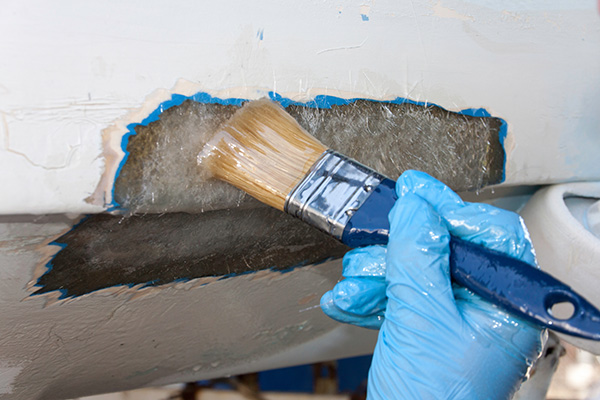
If you own a boat and spend any amount of time in saltwater, you’ve likely encountered the harsh realities of marine wear and tear. Scratches, cracks, and dings in your fiberglass hull might seem like easy fixes, especially with DIY kits and online tutorials readily available. However, when it comes to repairing fiberglass in a saltwater environment, cutting corners can do more harm than good. There’s a reason marine professionals caution against DIY fiberglass work on vessels that face constant exposure to ocean conditions.
We'll explain why salt water is so punishing on fiberglass, why amateur repairs often fail, and why proper restoration requires the kind of expertise only a dedicated marine service can provide.
Why Saltwater Is Especially Tough on Fiberglass
Saltwater isn't just water with a bit of salt. It's a corrosive blend of minerals and organic compounds that aggressively degrades everything it touches. For boats made from fiberglass (a material designed to be durable and lightweight), saltwater presents a unique challenge.
Unlike freshwater, saltwater accelerates oxidation and promotes the intrusion of moisture into compromised surfaces. Once a fiberglass hull has been chipped, cracked, or poorly sealed, saltwater finds its way in. Over time, it penetrates the resin layers and begins to separate the fiberglass mat from the substrate beneath, leading to delamination. This weakens the boat's structural integrity and invites further damage, particularly when exposed to constant wave pounding.
Even small fractures can turn into significant structural risks if not repaired correctly, and cosmetic surface issues may hide deeper internal damage. Saltwater also speeds up the corrosion of embedded metal components, such as screws or fittings, which can compromise surrounding fiberglass if the sealant fails.
Common Reasons DIY Fiberglass Repairs Fail
Many boat owners try to fix minor fiberglass damage themselves to save money or avoid the inconvenience of hauling their boat to a shop. While that motivation is understandable, the results are often short-lived, especially in saltwater conditions.
One common issue is improper surface preparation. Before applying resin or a fiberglass patch, the damaged area must be thoroughly dried, sanded, cleaned, and etched to ensure a strong bond. In marine environments, moisture often remains trapped in micro-fractures. A DIYer might not notice this, which can lead to poor adhesion and eventual failure.
Using the wrong type of resin is another common misstep. There are different types—polyester, vinyl ester, and epoxy resins, and each has specific compatibility requirements. Mixing or misapplying these materials can result in peeling, soft spots, or bubbling once the boat returns to the water.
Another mistake involves layering. The number and direction of fiberglass mat or cloth layers matter. Without the proper number of layers, orientation, and curing time, the patch won’t match the strength of the original hull. Often, DIY patches are brittle and prone to cracking, particularly under the stress of ocean currents and high-speed wave impacts.
Finally, inadequate sealing is a major problem. Saltwater can easily seep into even the smallest voids or pinholes. If the repaired area isn't fully sealed with gel coat or marine-grade paint, water intrusion will compromise the repair, possibly faster than the damage you're trying to fix.
DIY Repairs Can Void Warranties and Insurance
In many cases, insurance providers require that certified marine technicians complete significant fiberglass repairs. DIY repairs, especially if improperly done, can result in denied claims if a future incident or structural failure can be linked to the amateur work. The same is true for warranties. If your boat is still under manufacturer or dealer warranty, attempting a fiberglass fix yourself could void your coverage.
Beyond the financial risks, it’s also a matter of safety. Structural failure caused by water intrusion or delamination can lead to dangerous situations on the water, particularly in open-sea conditions where rescue may not be immediate.
What Professional Marine Technicians Do Differently
Experienced technicians begin with a thorough inspection to determine whether the damage is limited to the surface or if it extends to deeper structural issues. Moisture meters, thermal imaging, and other diagnostic tools help determine the extent of water intrusion. Once the damage is assessed, professionals select the appropriate resin and reinforcement materials for the job.
A professional repair involves removing compromised material, properly preparing the bonding surface, and applying multiple layers of mat and resin with the correct technique. After curing, the surface is sanded, faired, and sealed to match the original hull, both in strength and appearance.
Most importantly, marine shops like Bulletproof Marine Services offer work backed by warranties. Their lifetime guarantee is a commitment to quality and peace of mind for boat owners navigating demanding environments.
When to Call a Professional
While there’s no shame in handling small cosmetic repairs like surface scratches or minor gelcoat touch-ups on your own, you should always seek professional help for:
- Cracks that penetrate the fiberglass layers
- Signs of delamination (bulging, sponginess, or discoloration)
- Soft spots on decks or hulls
- Damage near high-stress areas like transoms or motor mounts
- Recurring leaks after a previous repair
- Any impact damage from rocks, docks, or debris
If your boat spends most of its time in saltwater, it’s especially important to treat every fiberglass repair seriously. The long-term effects of salt, UV exposure, and wave impact require a repair that’s more than just cosmetic.
Trust Bulletproof Marine Services in San Diego, CA, for Lifetime-Backed Fiberglass Repairs
At Bulletproof Marine Services in San Diego, we understand what saltwater can do to a poorly repaired fiberglass hull. Our team utilizes professional-grade materials, advanced techniques, and meticulous care to ensure your boat is not only seaworthy but also well-protected for the long haul. And with our lifetime guarantee, you can head out on the water with total confidence.
Schedule your fiberglass repair consultation today and keep your boat strong, safe, and saltwater-ready with Bulletproof Marine Services.